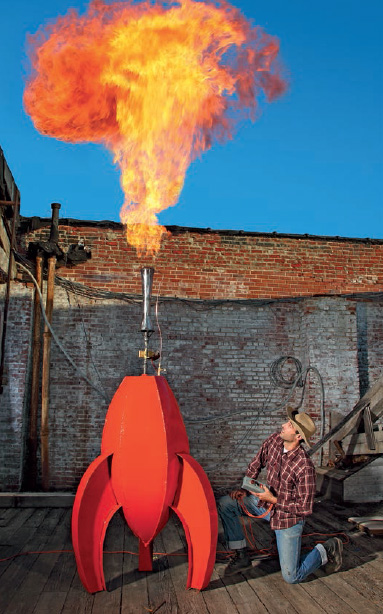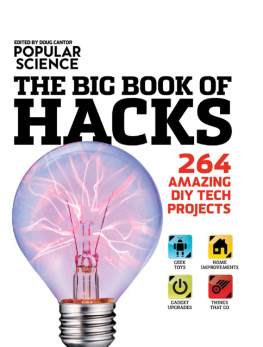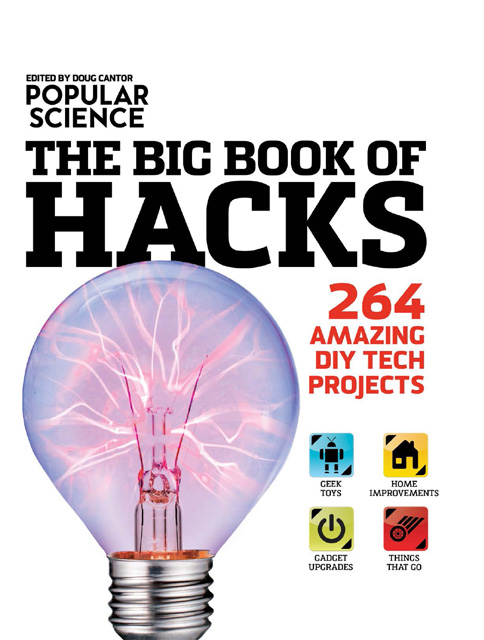FOREWORD

Anyone can make anything. That is the lesson of the 140 years that Popular Science has been in print. A determined person, working on the weekends, can escape gravity, break the speed of sound, or create a new means of communicating across great distances. And that inventive process begins by tearing things apart and rebuilding them again.
I cannot claim to have been the kind of kid who did that. My instincts around technology were always to keep my belongings clean, dry, and otherwise in perfect working order, not to dismantle or modify them. But my years at Popular Science have taught me that that instinct is the wrong one. There is simply too much technology at our disposal not to mess around with it. And when a determined person brings his or her inventive instincts to bear on the gadgets and gizmos that fill our lives, great things can result.
But this book isnt necessarily about building great things. Its about messing around, usually for the simple fun of it. The projects on these pages are based, in part, on the years weve spent pursuing the lone, sometimes crazed hackers who dont just modify technology but blow it apart, just to be able to say theyve done it.
I spent an afternoon with our staff photographer, John Carnett, who in his off time had replaced the motor on a four-wheel ATV with a jet engine. The thing required an elaborate start-up procedure and ear protection just to get it rolling, and as he drove me through his Philadelphia neighborhood in it, I cringed to imagine the incredible racket we were making, essentially that of a 747 taxiing past. And yet throughout the process, oblivious to the enemies he was making among the local parents, dogs, and nappers, John wore a look of joy and pride that had nothing to do with serving humanity or inventing something new. Hed just tricked something outhacked itin his own way, and in doing so had made his mark on the universe, not to mention on the neighborhood noise ordinances.
Its in that spirit that we, and especially our tireless senior editor Doug Cantor, bring you this entertaining collection of projects. We did it for the hell of it.

Jacob Ward
Editor-in-Chief
Popular Science
INTRODUCTION

I was an unlikely candidate to become the editor of How 2.0, Popular Sciences do-it-yourself column. Ive always been reasonably handy, but when it came to real hands-dirty, open-things-up-and-rearrange-the-parts hacking skills, I was a complete novice.
So I got into the DIY world the same way an experienced DIYer would work on a project: I did some research, talked to seasoned tinkerers, and then dove in. Early on I managed to build a tiny flashlight, hack my cell phones firmware, and make a pair of bookends from old CDs, all without causing too much damage. Over time I found that with a few hours, a small pile of parts from Radio Shack, and a little patience, I could build some really cool stuff.

Editing How 2.0 has also given me a window into the vast community of smart, dedicated people who have found about a million uses for things like solenoid valves and Arduino microcontrollers. The breadth of their innovations is truly astonishing, and thats what Popular Science has tried to show in the pages of How 2.0 each month. Weve featured projects ranging from a remote-controlled helicopter only 2 inches (5 cm) high to a remote-controlled bomber with a 20-foot (60-m) wingspan; from a portable solar-powered gadget charger to a 200-pound (90-kg) solar-powered 3-D printer; from a robot built from a toothbrush head to one that can mix and serve cocktails.
Many of these projects have found their way into this book, along with a host of entirely new ones. A few of them are just amazing, audacious things that almost no one could (or probably should) try. Most, though, are easier to replicate. Some take only a few minutes and require little more than gluing parts together.
So if youve never attempted to make anything before in your life, this book provides plenty of ways to start. From there you can take on some of the more challenging projects and develop new skills. Eventually, you might actually find yourself advancing your projects far beyond the versions in the book.
Whatever your skill level and area of interest, I encourage you to roll up your sleeves and (safely) give one of these projects a shot. At times you may get frustrated or even break something. But ultimately youll be surprised by what you can make, hack, tweak, improve, and transformand by how much fun youll have doing it.

Doug Cantor
Senior Editor
Popular Science
HOW TO USE THIS BOOK
So you want to hack stuffto tear it apart, put it back together with other components, and make it new. We at Popular Science salute you, and weve put together these projects to get you started. Many of them come from our popular How 2.0 column, and many come from amazingly inventive individuals out there making cool stuff. (Check out the Thanks to Our Makers section for more info.)
Before starting a project, you can look to the following symbols to decode what youre facing.

If youre just breaking in your screwdriver and have never even heard the word microcontroller, try out these projects first. Designed to be doable within five minutesgive or take a few seconds, depending on your dexterityand to make use of basic household items, these tech crafts are the perfect starting ground for the newbie tinkerer.

These are the big onesthe ambitious projects that youll want to sink some real time and cash into, and that will challenge your skills as a builder. How much time and cash, you ask? And just how challenging? The helpful rubric below will give you an idea.


Popular Science has been doing DIY for a very long timealmost as long as the 140 years the magazine has been in print. Occasionally this book shares a DIY project from our archives so you can try your hand at the hilarious retro projects your grandfather and grandmother built back before, say, television or smartphones.

















